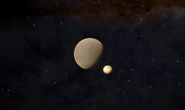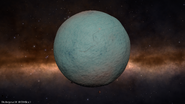
Europa in Sol
Moons are natural satellites. It is a smaller body that orbits around a larger body that is not a star or star remnant. The large mass of a planet makes a moon orbit around it, being held in the orbit by gravity. Larger planets usually have more moons. Gas giants can have many moons.
Natural bodies which orbit planets are called moons. Artificial bodies are manmade Stations, Installations, Tourist Beacons, Listening Posts, Unregistered Comms Beacons or other satellites.
Only larger, ball shaped moons are displayed in the game. The game does not distinguish moons, planets and dwarf planets other than by the orbit and the size. The same types of celestial bodies that constitute planets, also constitute moons and submoons orbiting moons.
Notable Moons[]

a Type-6 Transporter and a moon
Here's a list of notable moons in the Milky Way galaxy.
- Earth - 1 moon, the Moon
- Mars - 2 moons, not visible in the game
- Jupiter - 67 moons, only Io, Europa, Ganymede and Callisto are visible
- Saturn - 62 moons, only Enceladus, Tethys, Dione, Rhea, Titan and Iapetus are visible
- Uranus - 27 moons, only Ariel, Umbriel, Titania and Oberon are visible
- Neptune - 14 moons, only Triton is visible
- Pluto - 5 moons, only Charon is visible
- Haumea - 2 moons, only Hi'iaka is visible, Namaka is not
- 90482 Orcus - 1 moon, Vanth
- Mitterand Hollow does a 360 degree orbit around its planet in just 1 minute and 26 seconds as a preserved bug.

















